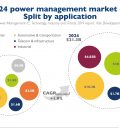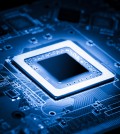When it comes to power management, analog designers are learning to love programmable

Dalla rivista:
EONews

The power management business is getting bigger by the day. Energy costs and environmental concerns are driving this, and neither is going to become less important any time soon. Depending on how you define power management, we estimate that it’s a market of some $15 billion for silicon devices. The market that we serve with Exar products is today worth about $1 billion, including analog and mixed signal devices – some of which have a big digital element.
One of the most important developments of recent years has been the growth in programmable power controllers, which use digital technology. Naturally, there was some reluctance on the part of analog designers to embrace digital devices but the arguments in favor of digital power management are now so compelling that they’re hard to ignore. This product area is a good fit for Exar because the company has a strong heritage in both analog and digital technologies. We’re not wedded to either one; we simply focus on developing silicon that produces the best possible functionality and efficiency for our customers, which are primarily in communications and industrial markets.
Consider designs that use FPGAs, DSPs, applications processors, media processors or microcontrollers. These usually need several voltage rails: 5V for analog, 3.3V for digital, 1.5V to 2.5V for memory and one for the processor core or cores.
To deliver these separate voltages using analog regulators takes a lot of components and a lot of board space. It adds complexity and it is very restrictive as the system design progresses.
A programmable digital power management controller cuts both component count and manufacturing costs. For example, one of our XRP77xx programmable switching controllers can form the basis of a 4-rail, flexible power control circuit using just 33 components. The chip itself is in a TQFN40 6mm x 6mm package and, depending on the exact part, the input voltage can be anywhere from 4.75V to 25V with user-configurable outputs from 0.6V to 5.5V. Similar functionality delivered from an analog circuit would need over 4X as many components, so it would be inherently less reliable – and even then would deliver inferior performance and features. But functional integration is only part of the story.
If you use analog regulators and you need to change any aspect of the power circuit you’ll need a board re-design, more component inventory and time to implement these changes. When your power management controller is programmable, in our case via a software design tool with a simple GUI, you eliminate these problems. You can very quickly adjust voltage rails, set up precision power sequencing, implement voltage and current monitoring, and program conditional fault handling.
As system development progresses, it’s very easy to adapt the power system to accommodate changes, so programmable power management can be a big help in reducing time-to-market for new products. But it goes further than that. We’ve come across instances where it’s desirable to make small changes to equipment in the field to improve its performance. Programmable power control facilitates this field serviceability. A simple firmware upgrade, delivered via an integrated I2C interface on the power controller can be used to take a supply rail up from 1.2V to 1.3V, for example, in order to improve the performance of the part of the system it feeds. A lot of designers have learned that the nominal voltage supply figure shown in a semiconductor data sheet is not always that at which it will deliver best performance in a given application.
In addition to these advantages, programmable power controllers give you the opportunity to minimize system energy consumption under all load conditions. This is important because many systems operate well below full load for much of the time. For example, a data center only gets close to operating at full load during periods of maximum data throughput. That might only happen for 10% of the time. You also need to minimize energy consumption for the other 90%. Distributed power architectures using point-of-load converters and programmable controllers give you that capability.
Power management is not just going digital, it’s going programmable. And with the right tools to simplify the programming, analog designers are now learning to love digital, rather than shying away from it.
The italian version on EONews 565-June
James Lougheed, vice president, power management and ams products, Exar Corporation
Contenuti correlati
-
Le migliori applicazioni per l’IoT nel nuovo mondo degli IC di power management: una panoramica
Questo articolo analizza la tecnologia delle batterie per l’Internet of Things (IoT). Descrive alcuni dei problemi di alimentazione che i progettisti devono affrontare e fornisce le soluzioni proposte da Analog Devices. Queste soluzioni sono altamente efficienti e...
-
onsemi inaugura il design center di Milano
Progettare, collaudare e validare sistemi e prodotti per migliorare la gestione dell’alimentazione negli ambienti di data center, e risparmiare energia, è la missione al centro delle attività del design center di onsemi a Milano. Il centro di...
-
Il mercato degli IC per power management
Il mercato del power management ha raggiunto i 18,5 miliardi di dollari nel 2019, ma gli analisti di Yole Développement ritengono che questo segmento, malgrado le apparenze, non sia ancora in una fase di consolidamento e si...
-
Exar: soluzioni di videosorveglianza DVR ad alta risoluzione
Exar ha annunciato il rilascio della soluzione Digital Video Recorder (DVR) PCI Express (PCIe), progettata per applicazioni di videosorveglianza professionali. VRC7008E esegue la codifica H.264 su otto canali fino a 960H / PAL NTSC a piena risoluzione...
-
Dialog Semiconductor acquista Atmel per 4,6 miliardi di dollari
Dialog Semiconductor ha annunciato di avere raggiunto un accordo per rilevare la rivale americana Atmel in un’operazione in contanti e azioni del valore complessivo di circa 4,6 miliardi di dollari. Con questa operazione, ulteriore conferma del consolidamento...
-
Exar: interfaccia front-end analogica per sensori
Exar ha introdotto un’interfaccia front-end analogica altamente integrata (XR10910) che offre un multiplexer differenziale 16:1, DAC, amplificatore per strumentazione a guadagno programmabile e un voltage reference. XR10910 opera da 2.7V a 5V e offre una vasta gamma...
-
Exar: amplificatore buffer VCOM
Exar ha annunciato un prodotto di controllo VCOM di prossima generazione basata su un brevetto di architettura innovativa. Exar, attraverso la sua fusione con IML, ha aumentato la sua presenza nel settore dei prodotti analogici a pannello,...
-
Exar: PMIC universale
Exar ha presentato il XR77128, un PMIC universale che controlla fino a 4 stadi esterni di potenza DrMOS indipendenti, per correnti maggiori di 40A per i più recenti processori ARM a 64-bit, FPGA, DSP e ASIC. Il...
-
Gli sviluppi degli IC per il power management
I dati che emergono dal report “Power Management IC Market – Global Industry Analysis, Market Size, Share, Growth, Trends And Forecast, 2013 – 2019” di Transparency Market Research indicano che il settore degli IC per applicazioni di...
-
Alimentazione: alcuni suggerimenti (parte 45) – Gestione dei transitori di carico di/dt elevati (Parte 2)
Nel Power Tip 44 abbiamo esaminato i requisiti di bypass dei condensatori per i carichi con elevate variazioni di corrente dinamica. Abbiamo sottolineato l’importanza di disporre di condensatori con un’induttanza in serie equivalente (ESL) ridotta e vicini...

















